

e-mail :  ( Please write in ' Subject ' entry : ' METAPHYSICS ', in order for me to be able to distinguish your mail from spam )
( Please write in ' Subject ' entry : ' METAPHYSICS ', in order for me to be able to distinguish your mail from spam )
Most expressing example of the type :
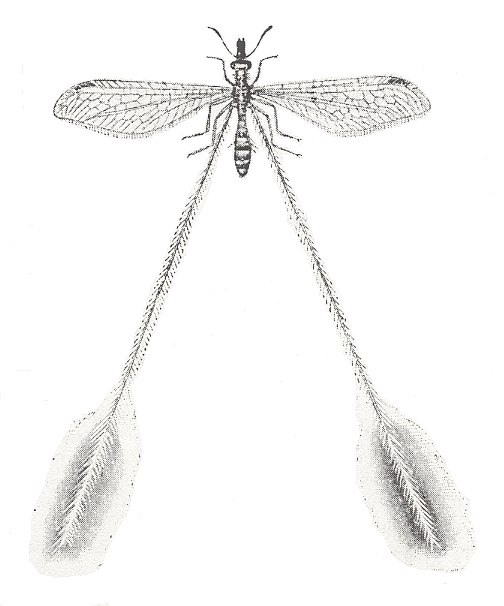
Figure 1: Croce filipennis. Wingspan about 25 mm. India. Family Nemopteridae, Order Neuroptera.
(After RICHARDS and DAVIES, 1977)
Description of the type
Morphological features
Both pairs of wings differ strongly from one another as to their shape. The structure of the skeleton of the thorax shows greater development of the mesothorax. Muscular apparatus little investigated. Forewings broad, oval or triangular. Hindwings narrow, very elongate, sometimes in the form of narrow almost straight or screw-like rounded lobes, significantly longer than the body. Wing venation of forewings shows moderately expressed specialization consisting in the straightening of the anterior margin and in costalization. Venation of hindwings very peculiar and consists of veins that run either centrally or evenly distributed over the whole wing membrane. No costalization. The insects usually are big, more rarely of medium size. The body is significantly shorter than the wings, not displaying any strongly expressed aerodynamic specializations.
Functional features
Flight not especially investigated. Therefore, the nature of the motion of the wings during flight is not known to me [Rohdendorf]. Personally I have not seen living insects of this type. [In RICHARDS and DAVIES, 1977, they, the Nemopteridae, are described as follows : " They are striking and beautiful insects flying with a curious up-and-down motion after the manner of Ephemerids [mayflies], with the long hindwings streaming in the air."]. The structure of the wings in representatives where the type is most clearly expressed - Nemopteridae [Neuroptera] and certain Saturniids {Lepidoptera] -- forces one to assume a significantly different nature of the beats of both pairs. The number of beats of the forewings must be considerably higher than that of the hindwings. The long ribbon-like [hind] wings of the Nemopteridae are not expected generally to be able to execute beats with the usual-for-wings amplitude. Their motion must be very peculiar. The basic physical parameters of flight -- speed, wing-beat frequency, maneuverability, persistence of flight -- are not known. The values of load per unit of wing surface during flight are low, and, probably a little more than we have it in platypterygia. The biological significance of flight is not investigated, so it only remains to suppose the importance of this function in the two best known groups -- the moths Saturniidae and the neuropterans Nemopteridae, being for a large part of their life in the air, for whom this function plays an important role in the process of reproduction.
Differentiation, connections and representatives of the type.
It is clear that the well known, but not the only, source of this type is the platypterygia of the Lepidoptera. In the representatives of the chief subtype of platypterygia changes can be observed characteristic of uropterygia and consisting of the formation of narrow appendages -- "tails" on the margin of the hindwing. Such appendages, undoubtedly having a determined aerodynamic significance as propelling devices creating traction force, are, in certain forms, present in up to triple-quadruple fashion, increase in size, and finally surpass the remainder of the body as to length. In spite of the relatively low distribution of this type, all known representatives divide into three subtypes characterized by different degree of development of the features of this type, their greater or lesser specialization.
1. Proturopterygia (primitive tail-wingedness)
This is a subtype that includes forms directly connected with the primitive type, still having broad fore- and hindwings : the latter carry, developed in different degrees, outgrows ("tails"), as to their size smaller than the remaining part of the hindwing. To this subtype do belong a number of lepidopteran genera of the families Plebejidae, Papilionidae (Papilio, s.l., Thais), and Uraniidae. See Figures.
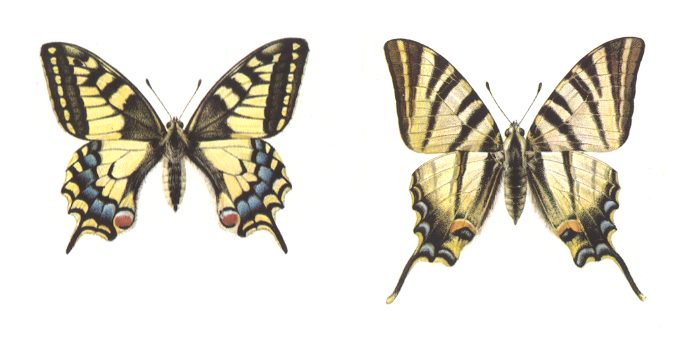
Figure 2 :
Left : Papilio machaon. Winspan 34-45 mm. Family papilionidae, Order Lepidoptera.
Right : Iphiclides podalirius. Wingspan 35-45 mm. Family Papilionidae, Order Lepidoptera.
(After SEVERA in Thieme's Insektengids, 1977)
3. Europterygia (eu-uropterygia, true tail-wingedness)
This subtype includes some forms of Lepidoptera and Neuroptera, such as certain Saturniidae and Papilionidae (Leptocircus), and Nemopteridae (Neuroptera), characterized by a transformation of the tails of the hindwings into long narrow appendages, essentially making up the whole wing. The unchanged broad part of the wing is almost entirely absent, being merely the base of the large tail. See next Figure.
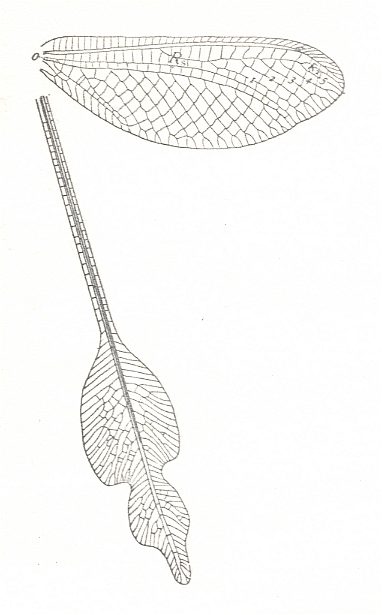
Figure 3 : Wings of Oliverina extensa. Family Nemopteridae, Order Neuroptera.
(After COMSTOCK, 1918)
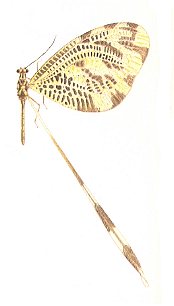
Figure 4 : Nemoptera coa. Family Nemopteridae, Order Neuroptera. Length of hindwing, about 38 mm.
(After CHINERY, in Elseviers Insektengids, 1983.)
3. Meturopterygia (ultra tail-wingedness)
Finally, in certain Nemopteridae (Croce) (Neuroptera) also the forewings show special transformations. They take up a more narrow shape, while the transformed hindwings attain very great length. This subtype, which may be called ultra tail-wingedness or meturopterygia, is also the most specialized. The lepidopterans of the subfamily Himantopterinae certainly also belong to this type. These insects are almost unknown to me [Rohdendorf], I only know of a concise description of them. So this doesn't allow me to determine more precisely their interrelationships and to what subtype they belong.
See Figure 1, and also next Figure for detailed depiction of venation of forewing.
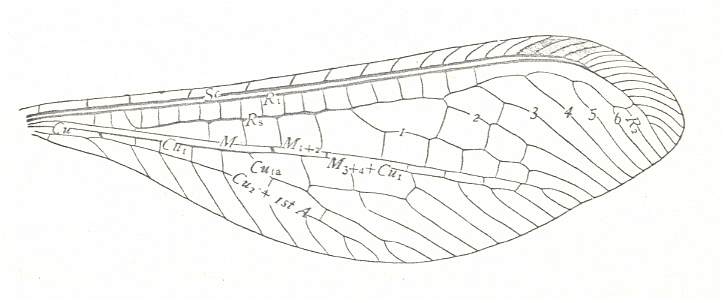
Figure 5 : Fore wing of Croce filipennis. Family Nemopteridae, Order Neuroptera.
(After COMSTOCK, 1918)
Tail-wingedness represents a peculiar way of specialization of broad-wingedness, in which [specialization] the hindwings obtain a different function, changing their shape and not participating in simultaneous beats with the forewings. Further differentiation in this type still more changes the function of the hind pair of wings, which [pair], -- while changed into peculiar organs, and thereby totally having lost significance in sustaining the body during flight, -- only functions in producing traction (and, in extended differentiation, also losing this). It is natural to speculate on what will happen later on in the evolution of such wings, namely the complete reduction of the hindwings as organs of flight, i.e. the attainment of features of two-wingedness.
e-mail :
 ( Please write in ' Subject ' entry : ' METAPHYSICS ', in order for me to be able to distinguish your mail from spam )
( Please write in ' Subject ' entry : ' METAPHYSICS ', in order for me to be able to distinguish your mail from spam )
To continue click HERE for further study of the types of flight-devices in insects, Part XIII, Ptilopterygia.
Back to first part of theoretic intermezzo
Back to second part of theoretic intermezzo Back to Part IX